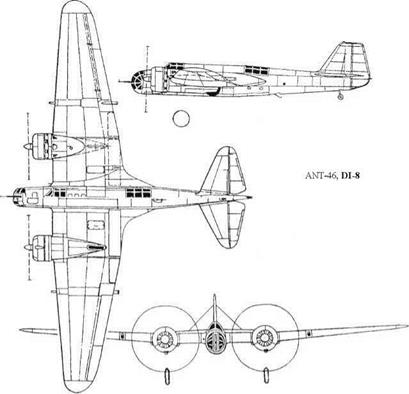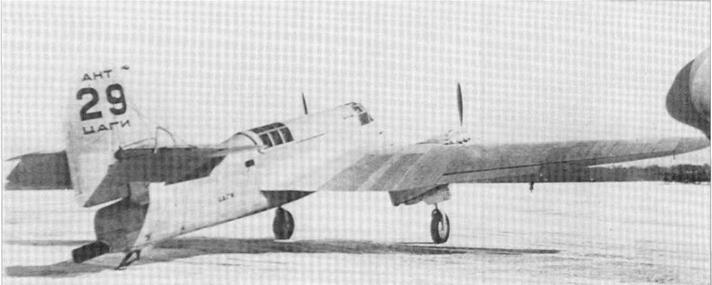Tsybin RSR Derivatives
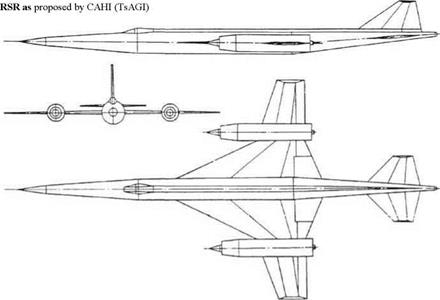
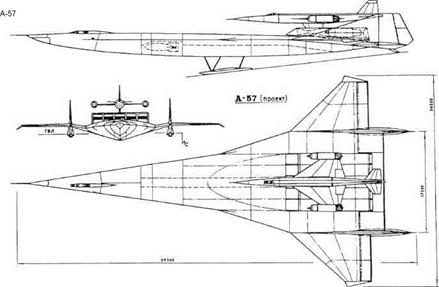
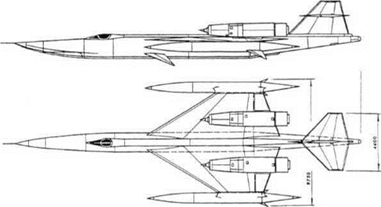 |
For interest, drawings are reproduced here of various projects which stemmed from the RSR. The first shows the way CAHI (TsAGI) wanted it. The purist aerodynamicists in that establishment were convinced that this supersonic-cruise aircraft ought to have true supersonic wings, with sharp edges and a trapezoidal (parallel double wedge) profile instead of a traditional curved aerofoil. As this would have meant a very long take-off run they proposed to add substantial wings outboard of the engines, giving a span of 14.5m (47ft 6%in), requiring total redesign and a dramatically inferior aircraft. The next drawing shows the awesome A-57, proposed in 1957 by R L Bartini, who featured on previous pages. There were several versions of this and the considerably smaller Ye-57. The A-57 shown would have been powered by five Kuznetsov NK-10 engines, each of 25,000kg (55,115 Ib) thrust. This 320 tonne (705,467 Ib) vehicle, with a length of 69.5m (228ft) and wing area of 755m2 (8,127ft2), was to have been water-based for operational flexibility and to avoid having to use vulnerable airfields (though it also had skids for airfield landings if necessary). It would have carried a 244N thermonuclear bomb internally, as well as a 2RS (later RSR) carried pick-a-back to the target at 2,500km/h (l,553mph, Mach 2.35) to serve as an accompanying reconnaissance aircraft. Together they could cover targets within a radius of 5,000km (3,107 miles), the Tsybin 2RS reconnaissance vehicle using its fuel only on the return flight. The final drawing shows the Tsybin RGSP, also dating from 1957. This too would have been water-based, with a planing bottom, engines moved above the wings to avoid the spray (minimised by the down-angled water fins), and with the external tanks serving as wingtip buoyancy bodies. This version was not equipped for airfield landings.
Purpose: To build an improved fighter armed with APK-4 guns.
Design Bureau: Brigade led by Viktor Nikolayevich Chernyshov inAGOS (Department of Aeroplane and Hydroplane Construction), whose Chief Constructor was A N Tupolev.
Towards the end of the 1930s there was great activity in the still chaotic aircraft industry of the embryonic Soviet Union. Part of this effort was concerned with making use of the large-calibre recoilless guns devised by L V Kurchevskii. These had various designations
but the most common was APK (Avto – matichyeskaya Pushka Kurchevskogo, automatic cannon Kurchevskii). Such guns were invented by Cdr Cleland Davis, ofthe US Navy, and developed in England from 1915. The idea was that, if the recoil of the projectile could be balanced by a blast of gas and possibly an inert mass fired to the rear, then aircraft could use lightly made weapons of large calibres. Russian copies were produced by Professor B S Stechkin in 1922-26, and in 1930 Leonid Vasil’yevich Kurchevskii restarted this work and developed a range of weapons of different calibres. Of these the most immedi-
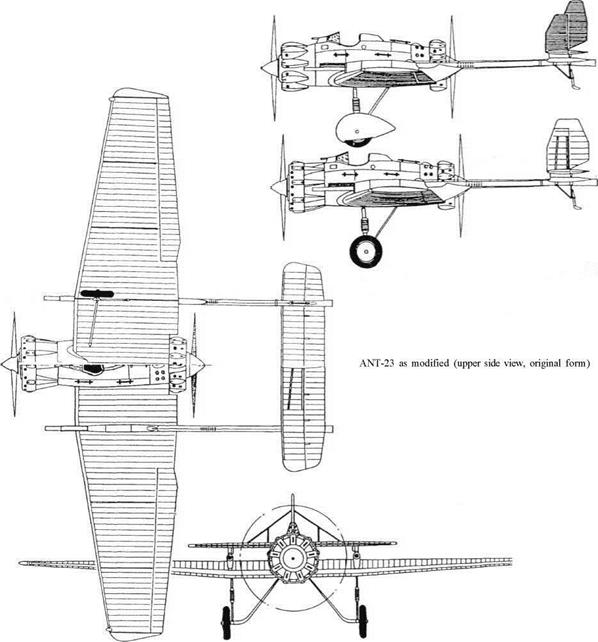 |
ately important was the APK-4, with a calibre of 76.2mm (Sin). Together with the Grig – orovich Z (later I-Z) described earlier, the ANT-23 was the first aircraft specially designed to use these guns. The AGOS designers had the idea that, instead of just hanging the guns under the wings, they could be put inside strong tubes which could then attach the tail to the wing. This enabled the central nacelle to have an engine at each end, giving outstanding flight performance. Design began in June 1930, and the first flight was made by Ivan Frolovich Kozlov on 29th August 1931. On 21st March 1932 he was
undertaking firing trials at about 1,000m (3,280ft) when the diffuser section at the rear of the left gun exploded. This severed the tail controls in that boom, but he managed to make a normal landing, the boom collapsing during the landing run (he received the Order of the Red Star). The fault was soon corrected, and from autumn 1931 a second prototype (called a doobler), the ANT-236/s, was built. This received service designation I-12, and was also named Baumanskii Komsomo – lets after the revolutionary who until his death in 1905 had worked next to the AGOS site. It incorporated various minor improvements, one of which was to arrange for the pilot in emergency to detonate a charge which severed the drive shaft to the rear propeller prior to baling out. Work was halted during the investigation into the accident to the first aircraft, and by 1933 the I-12 was overtaken by the Grigorovich IP family and the DIP, ANT-29. Work on it was stopped on 1st January 1934.
Structurally the ANT-23 followed Tupolev tradition in that it was a cantilever monoplane made entirely ofaluminium alloy, but it broke new ground in that corrugated sheet was not used except on the fin and rudder. Instead, the central nacelle had smooth skin, and the wings were skinned in sheets cut to a uniform
width of 150mm (Gin), wrapped round the leading edge. The edge of each strip was rolled to have a channel section, so that the complete wing appeared to have a skin with widely spaced corrugations. In usual Tupolev fashion, the aileron chord extended behind the trailing edge ofthe wing. The nacelle was welded from KhMA steel tube, with much of the light-alloy skin being in the form of detachable panels. At each end was an imported 480hp Gnome-Rhone GR9K (licence-built Bristol Jupiter) in a cowling with helmets over the cylinders. Above each wing was attached a precision-made tube of high-strength steel formed by screwing together three sections each machined to an internal diameter of 170mm (6%in). Wall thickness varied from 1 to 3mm. Over the wing the tube was faired in by thin aluminium sheet, and at the tail end was a gas diffuser. Above this was a shallow platform to which was attached the tailplane, carrying the strut-braced fin in the centre. Tall sprung tailskids were attached under each tube, and originally the rubber-sprung main landing gears had spats, though these were later omitted. Inside each tail boom was installed the 76.2mm APK-4, with the front of the barrel projecting. Soon the engines were replaced by the 570hp version made under
licence in the Soviet Union as the M-22, and the helmets were incorporated into ring cowls. Another modification was to replace the vertical tail by a redesigned structure with the same kind of skin as the rest of the aircraft.
When work began it was thought that this aircraft might be a world-beater. It was soon evident that the performance was well short of expectations, partly because ofthe fact that the rear propeller worked in the slipstream of that in front. Perhaps the greatest shortcoming of this aircraft was the fact that the ammunition supply for each gun was limited to two rounds.
![]()
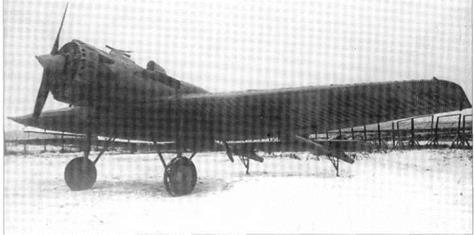
|
||||||||||||||||||||||||||
|
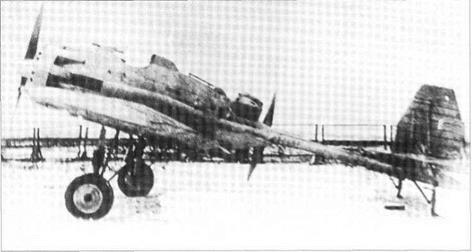
Purpose: A heavy fighter with large-calibre recoilless guns.
Design Bureau: KOSOS-CAHI (department of experimental aeroplane construction, central aero-hydrodynamics institute), Chief Constructor A N Tupolev.
This large fighter was a natural successor to the ANT-21 MI-3 (MI = multi-seat fighter) ordered in January 1932 and flown in May 1933. Whereas that aircraft had had conventional armament, the ANT-29 or DIP (Dvukhmestnyi Istrebitel’ Pushechnyi, two-seat cannon [armed] fighter) was designed around two of the largest available calibre of APK recoilless guns (see preceding story). Funds for a single prototype were made available by the WS in September 1932. Tupolev entrusted the design to his first deputy P O Sukhoi. Normally the aircraft would have flown in about a year, but priority was given to the ANT-40 fast bomber (which flew in 1934 as the SB), and the ANT-2 9 was not completed until February 1935. Flight testing was started by S A Korzin – shchikov, who reported that the flight controls, especially the ailerons and rudder, were unacceptably ineffective. This prototype was returned to CAHI’s ZOK (factory for prototype construction) for rectification, the main task being to re-skin the control surfaces. Testing resumed in late 1935, but by this time the ANT-46 (DI-8) was flying. The ANT-29 belonged to the previous generation, and it was abandoned in March 1936.
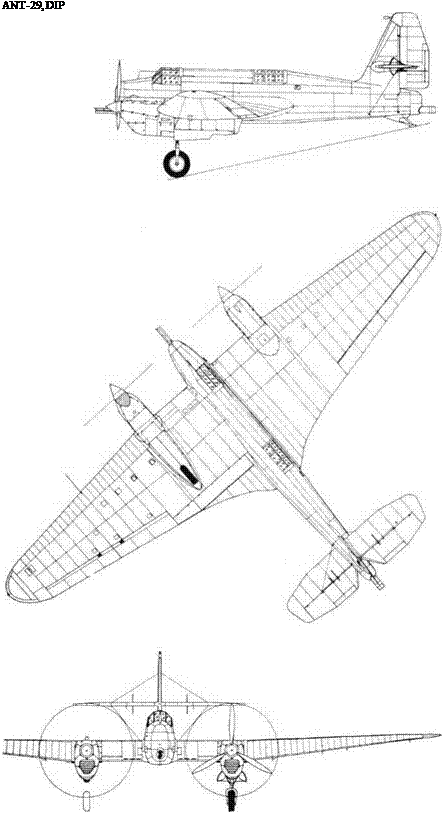 Like its predecessor, the ANT-21, the ANT – 29 was an aerodynamically clean monoplane powered by two liquid-cooled engines. The wings were aerodynamically similar but totally different structurally, and the engines likewise were quite new. They were two of the first 760hp Hispano-Suiza 12Ybrs 12-cylinder engines to be imported into the Soviet Union. Later this engine was developed by VYaKlimov into the VK-103 and VK-105, of which over 129,000 were constructed. In this aircraft they drove imported French Chau – viere three-blade variable-pitch propellers of 3.5m (138in) diameter. Carburettor air entered through a small inlet under the wing leading edge, and the radiator was in a shutter-controlled duct directly under the engine. The wing had a modern structure with two plate spars, made as a 3m (9ft 1 0in) horizontal centre section and 5.9m (19ft 4in) outer panels with taper and dihedral. Like the rest of the airframe the outer wing skins were smooth. In this Sukhoi broke new ground, previous ‘ANT’ aircraft having had corrugated metal skins showing that they originated in Junkers technology of the early 1920s. The short fuselage was of tall oval section and
Like its predecessor, the ANT-21, the ANT – 29 was an aerodynamically clean monoplane powered by two liquid-cooled engines. The wings were aerodynamically similar but totally different structurally, and the engines likewise were quite new. They were two of the first 760hp Hispano-Suiza 12Ybrs 12-cylinder engines to be imported into the Soviet Union. Later this engine was developed by VYaKlimov into the VK-103 and VK-105, of which over 129,000 were constructed. In this aircraft they drove imported French Chau – viere three-blade variable-pitch propellers of 3.5m (138in) diameter. Carburettor air entered through a small inlet under the wing leading edge, and the radiator was in a shutter-controlled duct directly under the engine. The wing had a modern structure with two plate spars, made as a 3m (9ft 1 0in) horizontal centre section and 5.9m (19ft 4in) outer panels with taper and dihedral. Like the rest of the airframe the outer wing skins were smooth. In this Sukhoi broke new ground, previous ‘ANT’ aircraft having had corrugated metal skins showing that they originated in Junkers technology of the early 1920s. The short fuselage was of tall oval section and
|
Dimensions |
||
|
Span |
19.19m |
62 ft min |
|
Length overall |
11.65m |
38ft23/4in |
|
(excluding guns) |
ll. lm |
36 ft 5 in |
|
Wing area |
56.88 nf |
612 ft2 |
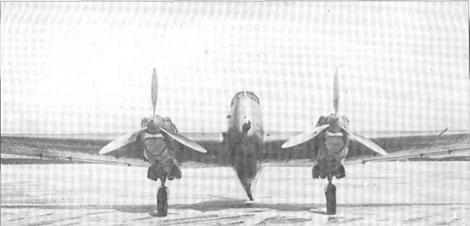
|
Weights Empty Fuel/oil Loaded (normal) (maximum) |
3,876kg 720+80 kg 4,960kg 5,300kg |
8,545Ib I, 587+176 Ib 10,935 Ib II, 6841b |
|
Performance |
||
|
Max speed at sea level, |
296km/h |
184 mph |
|
at 4 km (13, 123 ft) |
352 km/h |
219 mph |
|
Time to climb 3 km (9,842 ft) 5.6 min |
||
|
5 km (16,400 ft) No other reliable data. |
9.6 min |
|

![]()
seated the pilot in the nose under a rearward – sliding canopy and a backseater over the trailing edge under a forward-sliding canopy (as in early versions of the SB). The backseater would have worked radio had it been fitted, but his main task was to check the automatic reloading of the guns and clear stoppages. The wings were fitted with large two-part ailerons and split flaps, while the tail carried the wire-braced tailplane high up the fin, the elevators and rudder having large Flettner (servo) tabs. Like the ANT-21 and SB, the main landing gears had single shock-struts with a fork carrying the axle for a braked wheel with a 900 x 280mm tyre which, after retraction to the rear, partially projected to minimise damage in a wheels-up landing. At the rear was a large tailskid. Main-gear retraction, like flap operation, was hydraulic. The primary armament comprised two APK – 8 recoilless guns, also known as DRP (Dy – namo-Reaktivnaya Pushka), mounted one above the other. The feed was via two chutes on opposite sides of the fuselage. Each gun
had an unrifled barrel about 4m (13ft lin) long, with a calibre of 102mm (4in). The firing chamber was connected at the rear to a recoil tube terminating in the recoil-cancelling divergent rear nozzle, extended a safe distance behind the rudder, through which propellant gas blasted when each round was fired. Sighting was done with an optical sight in a prominent fairing ahead of the windscreen, and could be assisted by firing tracer from two 7.62mm ShKAS machine guns in the wing roots (these are shown in Shavrov’s drawings, but unlike the main armament they do not appear ever to have been installed). It was intended also to fit a pivot-mounted ShKAS in the rear cockpit. There was no provision for a bomb load. Arguments over armament continued, but no attempt was made to test the ANT-29 with the alternative forward-firing armament ofa20mm ShVAK in each wing root.
By the time it was on test this was no longer an important aircraft, and (for reasons not recorded) it failed NIl-WS testing.
Purpose: An improved heavy fighter with large-calibre recoilless guns.
Design Bureau: KOSOS-CAHI, chief constructor A N Tupolev, who assigned this aircraft to A A Arkhangel’ skii.
This aircraft was a derivative of the SB (ANT-40) fast bomber. The single prototype was ordered in November 1934, on condition that the SB (the first prototype of which had flown a month previously) had priority and would not }n any way be delayed. The DI-8 was created quickly and was flown by Yu A Alekseyev on 1 st August (also reported as 9th August) 1935. Factory testing was continued to June 1936, but the ‘liquidation’ of
Kurchevskii’s gun bureau and the arrest for treason and spying of Tupolev halted the programme.
Until recently little was known about the ANT-46, and only one photograph had been discovered. This did not show the nose clearly, and published accounts stated that the ANT-46 was based on the SB but had a metalskinned nose containing machine guns. It is now known that it had a glazed nose identical to that of the bomber. Instead of being a two-seat aircraft it also had a navigator/ bomb-aimer in the nose, and an internal bomb bay (for example, for eight FAB-100 bombs) with bomb doors. The interesting feature was that incorporated in each wing
outboard of the fuel tanks, between the split flaps and the ailerons, were single DRP (APK – 11) recoilless guns, each fed by an automatically indexed supply of 45mm (IXin) ammunition, the rear blast tubes projecting behind the trailing edge. Like the first SB the fin and rudder had a squared-off top, and the engines were not as previously thought GR14s but, as on the first SB, nine-cylinder Wright Cyclones of 710hp, driving Hamilton two-blade propellers. Like the ANT-29, this aircraft carried CAHI titles and the ANT number 46 on the tail.
This aircraft fulfilled expectations, but was considered an outdated concept.
|
||||||||||||||||||||||||||||||||||||||
|
